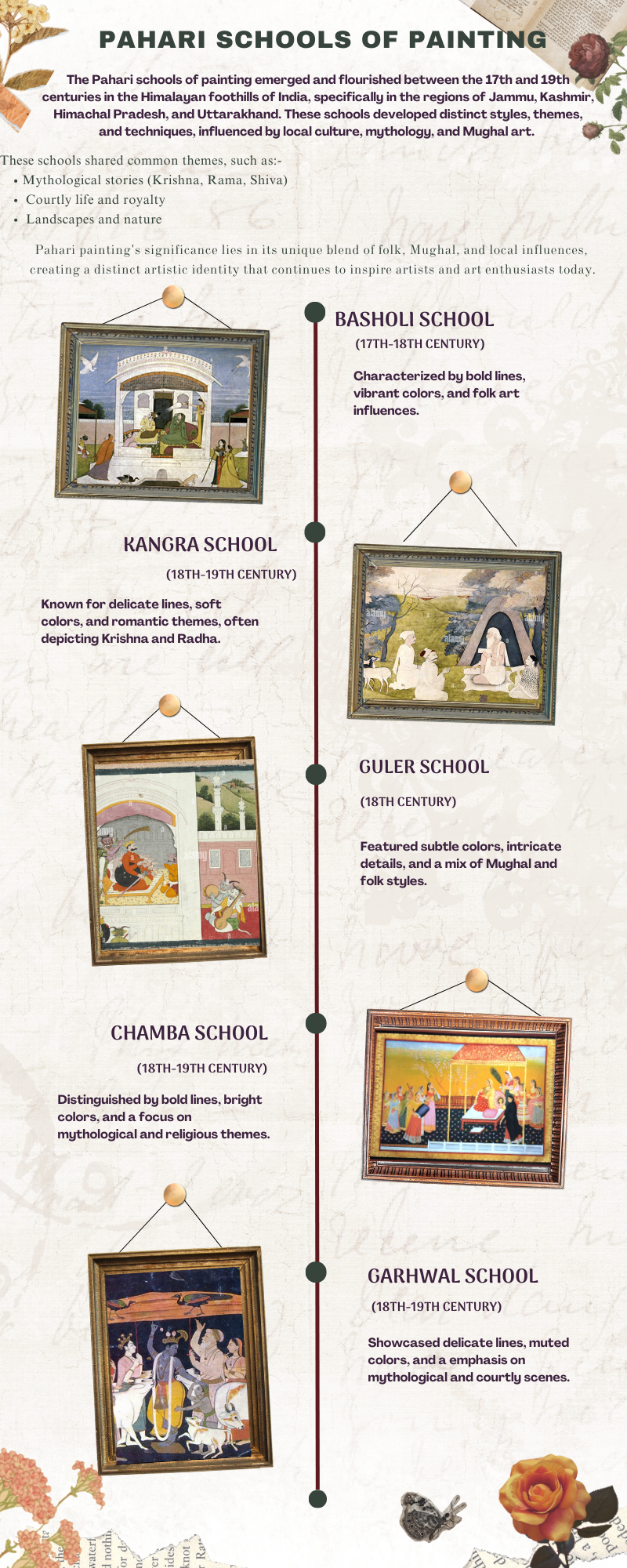What role do tribal paintings have in the representation of native cultures? How do they communicate values of community and identity?
The British colonial period significantly influenced Indian painting styles and themes, leading to a transformation in artistic expression through the introduction of Western concepts. Here are some key ways in which this influence manifested: 1. Introduction of Western Techniques Perspective and CoRead more
The British colonial period significantly influenced Indian painting styles and themes, leading to a transformation in artistic expression through the introduction of Western concepts. Here are some key ways in which this influence manifested:
1. Introduction of Western Techniques
- Perspective and Composition: Western artistic techniques such as linear perspective, chiaroscuro (the use of strong contrasts between light and dark), and realistic proportions began to be incorporated into Indian art. Artists started experimenting with depth and dimension, which contrasted with traditional Indian styles that often emphasized flatness and decorative elements.
- Oil Painting: The introduction of oil paints allowed for richer color palettes and more detailed textures. This medium was embraced by many artists, leading to a shift from traditional watercolors and natural pigments.
2. New Themes and Subjects
- Portraiture: The British fascination with portraiture led to a rise in the depiction of individual figures, including British officials and Indian royals. This marked a departure from traditional religious themes, focusing more on personal identity and status.
- Landscapes and Genre Scenes: European interest in landscapes prompted Indian artists to explore natural scenery and everyday life. Artists began painting landscapes that reflected local geography, often infusing them with romantic or idealized qualities.
3. Art Schools and Education
- Establishment of Art Schools: The founding of institutions like the Sir J.J. School of Art in Bombay (now Mumbai) in 1857 facilitated the formal training of artists in Western styles. These schools emphasized techniques such as perspective, anatomy, and composition, significantly influencing a new generation of artists.
- Influence of Academies: The British art academies encouraged a blending of Western and Indian styles. Some artists embraced European techniques while retaining traditional subjects, leading to unique hybrids.
4. Cultural Exchange
- Cross-Cultural Collaborations: Interaction between British artists and Indian painters led to collaborative works that merged styles. This cross-pollination fostered an environment where traditional Indian art was viewed through a Western lens.
- Travel and Exhibitions: Indian artists participated in international exhibitions, gaining exposure to global art movements and trends. This engagement helped elevate Indian art on the world stage while also introducing new ideas and techniques.
5. Nationalism and Revival Movements
- Response to Colonialism: In the late 19th and early 20th centuries, a reaction against colonial rule prompted many artists to seek a revival of indigenous styles and themes. This led to movements that aimed to reclaim traditional aesthetics, blending them with new influences from the West.
- The Bengal School of Art: Artists like Abanindranath Tagore sought to develop a distinctly Indian style that combined elements of traditional art with modern sensibilities. They emphasized Indian themes, folklore, and spirituality, contrasting sharply with the Western style that dominated during the colonial period.
6. Printmaking and Mass Production
- Introduction of Lithography: The colonial period saw advancements in printmaking techniques, enabling broader distribution of artworks and illustrations. This facilitated the spread of artistic styles and themes across different regions of India.
- Illustrated Books and Publications: The use of illustrations in books and magazines became popular, often depicting a blend of Western and Indian motifs, further influencing public taste and artistic direction.
Conclusion
In summary, the British colonial period profoundly influenced Indian painting styles and themes by introducing Western artistic concepts, techniques, and new subject matter. While this led to the emergence of hybrid styles and forms of expression, it also spurred movements aimed at reviving and preserving traditional Indian art in response to colonial influences. The resulting dynamic interplay has shaped the trajectory of Indian art, paving the way for contemporary expressions that continue to explore this rich cultural dialogue.
See less

Tribal paintings are significant representations of indigenous cultures, serving as powerful expressions of identity and community values. Here’s how they fulfill this role: 1. Cultural Heritage and Preservation Tradition and Continuity: Tribal paintings often reflect centuries-old traditions and prRead more
Tribal paintings are significant representations of indigenous cultures, serving as powerful expressions of identity and community values. Here’s how they fulfill this role:
1. Cultural Heritage and Preservation
2. Representation of Identity
3. Expression of Community Values
4. Spiritual Significance
5. Adaptation and Evolution
6. Cultural Dialogue and Awareness
Conclusion
In conclusion, tribal paintings hold immense significance in representing indigenous cultures by preserving traditions, articulating community values, and expressing identity. They serve as vital cultural artifacts that not only connect individuals to their heritage but also foster a sense of belonging and communal identity. As they evolve in modern contexts, these artworks continue to convey important messages about culture, identity, and the environment, ensuring their relevance in today’s world.
See less